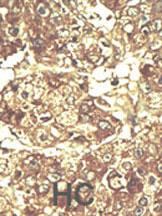PKA C-beta (PRKACB) Antibody (N-term)
Purified Rabbit Polyclonal Antibody (Pab)
- 产品详情
- 实验流程
- 背景知识
Application
| IHC-P, WB, E |
|---|---|
| Primary Accession | P22694 |
| Reactivity | Human |
| Host | Rabbit |
| Clonality | Polyclonal |
| Isotype | Rabbit IgG |
| Calculated MW | 40623 Da |
| Antigen Region | 14-43 aa |
| Gene ID | 5567 |
|---|---|
| Other Names | cAMP-dependent protein kinase catalytic subunit beta, PKA C-beta, PRKACB |
| Target/Specificity | This PKA C-beta (PRKACB) antibody is generated from rabbits immunized with a KLH conjugated synthetic peptide between 14-43 amino acids from the N-terminal region of human PKA C-beta (PRKACB). |
| Dilution | IHC-P~~1:100~500 WB~~1:1000 E~~Use at an assay dependent concentration. |
| Format | Purified polyclonal antibody supplied in PBS with 0.09% (W/V) sodium azide. This antibody is prepared by Saturated Ammonium Sulfate (SAS) precipitation followed by dialysis against PBS. |
| Storage | Maintain refrigerated at 2-8°C for up to 2 weeks. For long term storage store at -20°C in small aliquots to prevent freeze-thaw cycles. |
| Precautions | PKA C-beta (PRKACB) Antibody (N-term) is for research use only and not for use in diagnostic or therapeutic procedures. |
| Name | PRKACB |
|---|---|
| Function | Mediates cAMP-dependent signaling triggered by receptor binding to GPCRs (PubMed:12420224, PubMed:21423175, PubMed:31112131). PKA activation regulates diverse cellular processes such as cell proliferation, the cell cycle, differentiation and regulation of microtubule dynamics, chromatin condensation and decondensation, nuclear envelope disassembly and reassembly, as well as regulation of intracellular transport mechanisms and ion flux (PubMed:12420224, PubMed:21423175). Regulates the abundance of compartmentalized pools of its regulatory subunits through phosphorylation of PJA2 which binds and ubiquitinates these subunits, leading to their subsequent proteolysis (PubMed:12420224, PubMed:21423175). Phosphorylates GPKOW which regulates its ability to bind RNA (PubMed:21880142). Acts as a negative regulator of mTORC1 by mediating phosphorylation of RPTOR (PubMed:31112131). |
| Cellular Location | Cytoplasm. Cell membrane. Membrane; Lipid- anchor. Nucleus {ECO:0000250|UniProtKB:P05131} Note=Translocates into the nucleus (monomeric catalytic subunit). The inactive holoenzyme is found in the cytoplasm {ECO:0000250|UniProtKB:P05131} |
| Tissue Location | Isoform 1 is most abundant in the brain, with low level expression in kidney. Isoform 2 is predominantly expressed in thymus, spleen and kidney. Isoform 3 and isoform 4 are only expressed in the brain. |
For Research Use Only. Not For Use In Diagnostic Procedures.
Provided below are standard protocols that you may find useful for product applications.
BACKGROUND
cAMP is a signaling molecule important for a variety of cellular functions. cAMP exerts its effects by activating the cAMP-dependent protein kinase (AMPK), which transduces the signal through phosphorylation of different target proteins. The inactive holoenzyme of AMPK is a tetramer composed of two regulatory and two catalytic subunits. cAMP causes the dissociation of the inactive holoenzyme into a dimer of regulatory subunits bound to four cAMP and two free monomeric catalytic subunits. Four different regulatory subunits and three catalytic subunits of AMPK have been identified in humans. PRKACB is a member of the Ser/Thr protein kinase family and is a catalytic subunit of AMPK.
REFERENCES
Dwivedi, Y., et al., Biol. Psychiatry 55(3):234-243 (2004).
Cartier, C., et al., J. Biol. Chem. 278(37):35211-35219 (2003).
Higuchi, H., et al., EMBO J. 22(8):1790-1800 (2003).
Wu, K.J., et al., Oncogene 21(51):7872-7882 (2002).
Jiang, C.H., et al., Proc. Natl. Acad. Sci. U.S.A. 98(4):1930-1934 (2001).
终于等到您。ABCEPTA(百远生物)抗体产品。
点击下方“我要评价 ”按钮提交您的反馈信息,您的反馈和评价是我们最宝贵的财富之一,
我们将在1-3个工作日内处理您的反馈信息。
如有疑问,联系:0512-88856768 tech-china@abcepta.com.























 癌症的基本特征包括细胞增殖、血管生成、迁移、凋亡逃避机制和细胞永生等。找到癌症发生过程中这些通路的关键标记物和对应的抗体用于检测至关重要。
癌症的基本特征包括细胞增殖、血管生成、迁移、凋亡逃避机制和细胞永生等。找到癌症发生过程中这些通路的关键标记物和对应的抗体用于检测至关重要。 为您推荐一个泛素化位点预测神器——泛素化分析工具,可以为您的蛋白的泛素化位点作出预测和评分。
为您推荐一个泛素化位点预测神器——泛素化分析工具,可以为您的蛋白的泛素化位点作出预测和评分。 细胞自噬受体图形绘图工具为你的蛋白的细胞受体结合位点作出预测和评分,识别结合到自噬通路中的蛋白是非常重要的,便于让我们理解自噬在正常生理、病理过程中的作用,如发育、细胞分化、神经退化性疾病、压力条件下、感染和癌症。
细胞自噬受体图形绘图工具为你的蛋白的细胞受体结合位点作出预测和评分,识别结合到自噬通路中的蛋白是非常重要的,便于让我们理解自噬在正常生理、病理过程中的作用,如发育、细胞分化、神经退化性疾病、压力条件下、感染和癌症。







